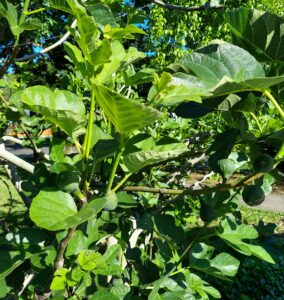Growing fruit trees is a rewarding hobby

“I love being able to go outside and grab a fresh piece of fruit for a snack – it’s healthy, seasonal, organic, and free.”
-Andrew Land (he/him), Neighborhood Trees Senior Specialist and home orchardist
Home orchardry is a rewarding hobby. Growing and maintaining fruit trees keeps you active, gets you outside, and provides fresh food. Fruit trees are also great trees for small spaces where larger trees just won’t work. Friends of Trees plants about 400 fruit trees every season, and they are an increasingly popular choice for yard trees.
Fruit trees are also a lifestyle—it’s a healthy one, but also one that requires regular, active involvement. As Andrew emphasizes, “Fruit trees are high maintenance. Growing fruit trees is a great lifestyle, but it’s not for everybody.”
Fruit trees require annual pruning, and they are pruned very differently than other trees. They also require extra attention: Home orchardists need to be on the lookout for pests & disease.
Location, location, location! Where fruit trees are planted makes a difference, particularly in terms of sun exposure for species susceptible to fungal disease. For instance, it’s ideal to plant fruit trees that are prone to fungal disease (e.g., European pear, some plum, some apple trees) in a location that gets early morning sun so that overnight dew on leaves has a chance to dry, thus offering some protection from fungal disease.
Friends of Trees works to source pest & disease resistant varieties, and provides all new fruit tree recipients with tree care information specific to fruit trees. However, it’s important to keep in mind that all fruit trees will always require extra monitoring and care (and resistance does not = immunity).
Still interested in growing fresh fruit in your own backyard?
In a typical season our top two recommended fruit trees are fig and persimmon. Why? Essentially they are the most pest & disease-free, they require less water, and they are generally low-maintenance. Another bonus of the persimmon tree is that it provides the last fruit of the year and so lengthens the season of food from your garden. If you’re up for more maintenance we usually also offer apple, plum, and pear trees. All of the fruit trees we offer are on semi-dwarf root stock because it is more drought tolerant than dwarf root stock and the roots of semi-dwarf stock anchor the tree more effectively.
By early fall we’ll know what fruit trees we can offer for the upcoming planting season since fruit tree availability varies largely due what’s available from the local nurseries we work with. On our wish list is the early ripening pawpaw, and if you’ve tried this special fruit you know why: pawpaws (which, fun fact, are the largest fruit native to North America) taste like a cross between mango and banana – !
Unlike most of the trees we plant, the cost of fruit trees is not supported by our municipal partners, who prioritize planting the largest trees possible because larger trees provide greater public health benefits. So beyond the $35 co-pay from tree recipients (which is waived if cost is a barrier to a household getting a tree), Friends of Trees is actually subsidizing fruit trees. Why? There are many benefits to growing fruit trees and, ultimately, we want people to grow trees.
More fruit tree resources are available from our friends at the Portland Fruit Tree Project.
Photo: Fig tree in an urban yard, June 2021 | Video: Jenny’s love letter to her Asian pear tree
